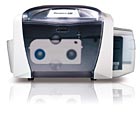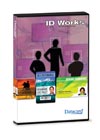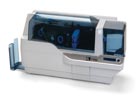
High volume needs call for a high volume solution such as this model from Team Nisca.

Desktop printers that stress simplicity and convenience to produce
professional IDs aim at lower volume needs and remote facilities.
Pictured is a printer from Fargo.
Her operation produces roughly 23,000 cards annually using four Team Nisca
printers.
But when it comes to features and benefits she looks for, her list is down-to-earth. “Speed, quality, easy to clean, keeping cards clean and free of dust. I need a menu available to personalize print job and network capability.”
Tatterfield, like some other security executives, spent her valuable time at the
frontend of a printer purchase. “We evaluated 14 companies with printers, had six onsite demos, had a team of six people, both technical and non-technical, evaluating nearly every aspect of the printers. After months of research, we collectively chose our printers. Research is the key along with a practical demonstration using your identification software to produce one of your cards on their printers before deciding on purchasing.”
PRINTERS EVOLVING
ID card printers, from numerous sources, continue to evolve.For example, Team Nisca, a business unit of Kanematsu USA, is spreading the word about its Thermo-ReWrite Patch overlaminate that can be applied by the laminator. Thermo-ReWrite or TRW technology prints quality images and text; erases and re-prints different data on the same card up to 500 times. As an enterprise solution, it aims at access controlled visitor cards, temporary employee badges, event access cards and even frequent shopper cards.
Such an approach offers dye-sub desktop customization. Traditionally, the film is applied to the card stock in the final assembly phase of the card production, but with the new film overlaminate solution, standard PVC cards can be customized with a dye-sub printer. Then, the inline laminator applies the film in the same manner a clear patch overlay is applied.
Quick printing, color and personalization are additional features sought by end-users.
At Europe’s CARTES 2006 event, Datacard showed enterprises a retransfer color printing module for edge-to-edge, full-color print and card personalization capabilities at speeds of up to 1,500 cards per hour -- fully inline with a broad spectrum of other personalization technologies. Such on-demand print capability allows issuers to efficiently consolidate small jobs, provides them with a solution to issue differentiated cards and helps operations reduce inventory costs, stock outages and scrap costs. The retransfer design allows card issuers to easily print on a broad spectrum of card stocks including polycarbonate, cards with contact and contactless smart card chips and cards with irregular surfaces. Process colors, spot colors, metallic colors and UV inks provide vivid images and enable customized card designs.

Software features can include customized card printing installations, advanced search capabilities, increased user password security, as well as the ability to import and export card designs between projects and batch import and export photos and images. Pictured is new software from Datacard.
SOFTWARE FEATURES IMPORTANT
The firm also boasted its ID Works identification software at CARTES 2006.This software’s new features include customized card printing installations, advanced search capabilities, increased user password security, as well as the ability to import and export card designs between projects and batch import and export photos and images.
Dual-sided printing also is a feature of interest to end-users.
One example comes from Zebra with a desktop plastic card printer/encoder. Printing on both sides of the card offers many options for designing more functional and more attractive personalized identification, security, gift and loyalty cards. More printed information can be added and larger photographs can be used for easier visual identification. Reduced crowding of information provides better readability. For example, the front of an identity/access control card could feature an employee’s photo and name, the organization’s logo and a color code for level of access, while the back could include a barcode, plus text of employee information such as height & weight, department, supervisor and level of clearance. Membership, loyalty and gift cards can easily be personalized with a photograph and the bearer’s name on one side, with details about store locations, maps, or even special promotions on the back.
Contact smart card encoding and magnetic stripe encoding are available. With these options, users can encode magnetic stripes and encode/read ISO 7816 contact smart chips (the most common contact smart card standard). This and other ID card printers offer built-in Ethernet connectivity as a factory-installed or field upgradeable option, allowing remote printing and remote encoding.
Faster and easier importing has a strong attraction to many end-users.
At Security Essen, Digital Identification Solutions showed an enhanced version of EDIsecure Card Management Software 2.0. During ongoing development of the software, the main interest was this time to increase the ease of use and to extend the performance by optimizing internal software processes.

Some card solutions call for more information to be printed than there is real estate on the front of the card. Some printers offer dual-sided printing such as this unit from Zebra.
Ease of use is a top enterprise requirement.
A Persona system from Fargo Electronics, appeals to K-12 schools, small corporations, clubs or recreation facilities that need high-quality plastic ID cards without high-security features. Complete set up takes just a few minutes, and the reliable performance of the printer means it runs virtually maintenance-free.
Fargo has also added ID card software in multiple languages available in French, German, Spanish, Italian and Portuguese. Build-A-Badge lets card program managers design ID cards, import or capture photographs and print single-sided cards with bar codes, text, logos and more, all from one application. Card designs can be selected from the library of templates, or can be easily created from scratch. When complete, the card template is saved and the personalized information is recorded to a database. To re-issue a lost or damaged card, the information can be recalled from the database, and the card reprinted.
There is also an end-user need for higher security.
One example is the high-security Magicard Tango +L from Ultra Electronics which features a robust metal construction for quality printing and long-term reliability. With a Plug & Play Windows driver, standard Ethernet and USB, and both hardware and software printer locking facilities, the Tango +L can include a customized Holokote. It ensures cards cannot be cloned. This special feature automatically prints a high security watermark into the overcoat panel during the print cycle without incurring extra consumables costs. The HoloKote pattern can be customized to your logo and text.
SIDEBAR: Solution Signposts for Printers
When evaluating card printers, consider the details of your solution – volume of cards produced, who will be operating the system, what will be on the cards or badges, the type of software being used and level of security.Diane Tatterfield, assistant director, CatCard Services at the University of Arizona, spent many hours involving numerous people in evaluating printers. Among her key elements:
- Speed
- Quality
- Easy to clean, keeping cards clean and free of dust
- A menu available to personalize print job
- Network capability
